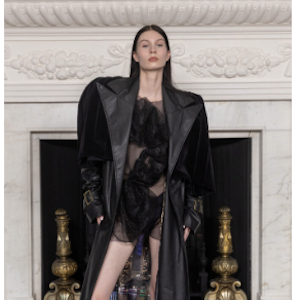Fashioning Masculinities
By Leah Bolling
There is no exact formula in regards to menswear; it is loose and ever-changing. From flamboyant clothes made for royalty, to draping garments that were carved into sculptures, to flamboyant clothes made for royalty. From uniform clothing made in mass production, to today’s fashion where gender norms are being challenged and the idea of uniformity is dwindling. We often think of menswear to be standard, or traditional, however if you look back in its history, you’ll find that men have been peacocks in regard to how they dress, even more than women.
Some men are considered to be “dandies,” who have always dressed “full-on” and nothing less. These radical dressers pushed the boundaries of fashion, specifically menswear, and were catalysts for progression throughout each new season. The abundant history of menswear proves to us that there are horizons being newly encompassed into mens fashion, and the definition of masculinity will always be reinvented time and time again.

In ancient times, Greek and Roman sculptures were created to depict men as the image of perfection and athleticism. Most of them were made to show men wearing very little clothing, if any. The few garments that they did wear were loose, soft, with no structure. In the marble statue of Apollo Belvedere, you can see Apollo standing with his arm stretched out and only a long piece of cloth draped along it. He is neither clothed nor nude. Even something so unstructured, such as Apollo’s cloth draped along his arm, has the ability to inspire the future of menswear such as shirts with swathed, ruched and pleated cloth.

On the other side of the scale, we see menswear used as a symbol of wealth. On the top of the food chain, in terms of social class, it was socially accepted for men to wear rich colours and nice fabrics. Royalty wore kinds of lush, rich clothing pieces. As seen in their portraits, powerful monarchs and members of royal families from all over the world are depicted to be wearing lavish, flamboyant clothing. Menswear, in this aspect, was very “peacock.” It was elaborate and intentional. It was strategically used to show power and wealth.

When Europe became industrial, clothing became more practical. During this time, black colored menswear dominated the streets. Tailors became exceptionally great at sculpting menswear into pieces that were flatteringly-masculine. Mass production allowed for this style to become more accessible to all. Men dressed in black suits filled the streets of London. There was a sense of uniformity. This time had an influence of deciding what the “standard” or the “norm” of menswear was. While this style is still popular today, there is a current movement that is reforming what “menswear” really means by redefining what we believe to be “masculine” and “feminine” and everything in between.


Today, we see a collage of all of these different styles make up the idea of menswear. Gender norms are changing rapidly, allowing for much experimentation and creative freedom when it comes to clothing and what it means to be “masculine.” The Victoria and Albert Museum in London features all of these concepts and more in the exhibit, “Fashioning Masculinities: A History of Menswear.” The exhibit features clothing from all different time periods. It also features modern clothing worn by celebrities from today’s pop culture such as Billy Porter, Harry Styles, Timothee Chalamet, and Bimini Bon Boulash. These are men who have repeatedly redefined what masculinity is. Menswear is something that will continue to evolve and achieve recognition across new horizons. It is truly an art and a space for beautiful, progressive creative expression.





